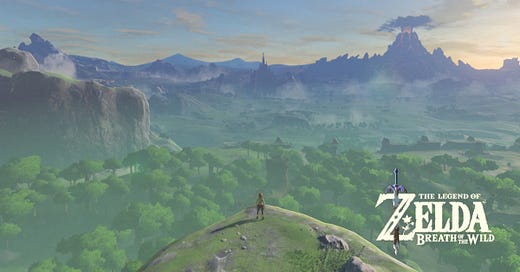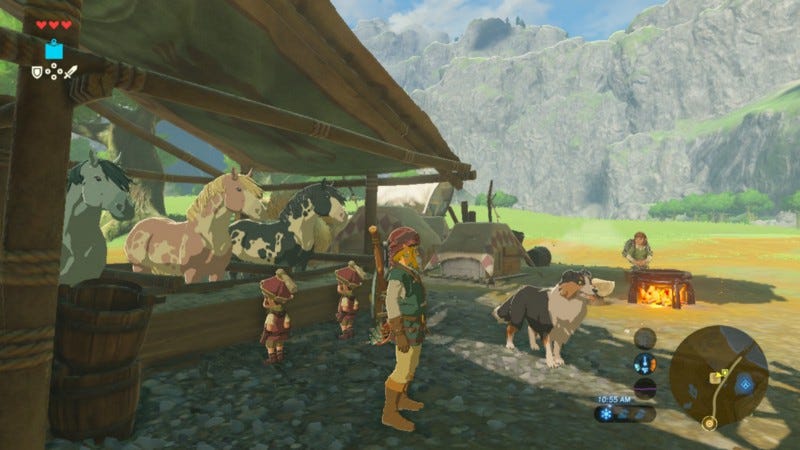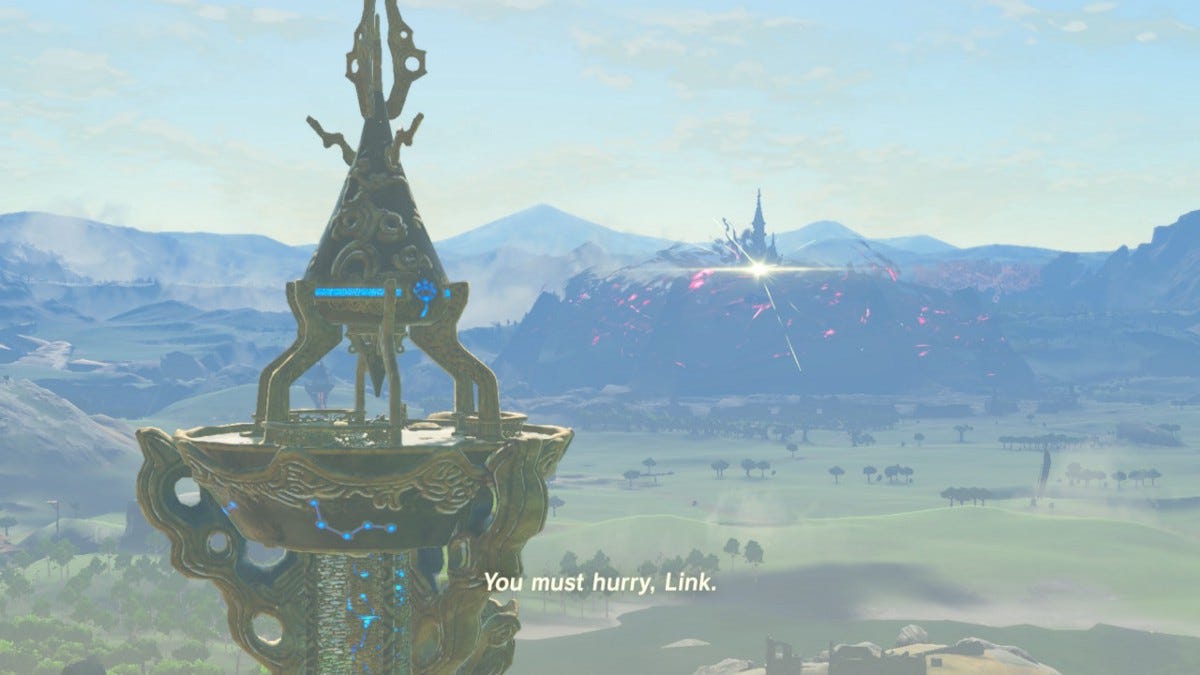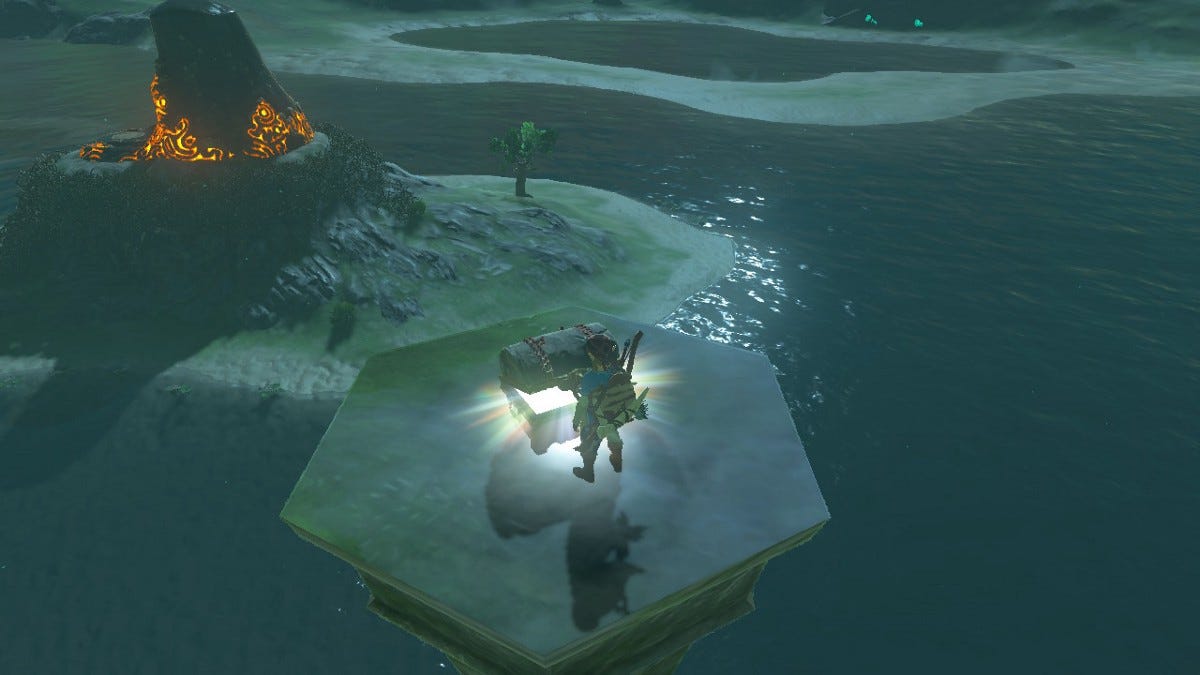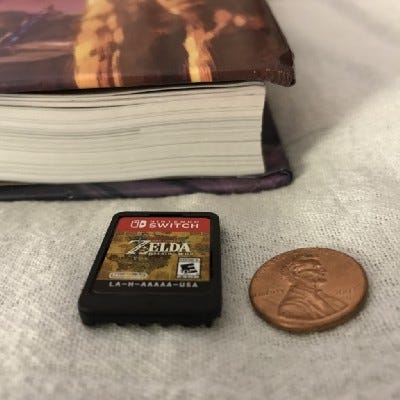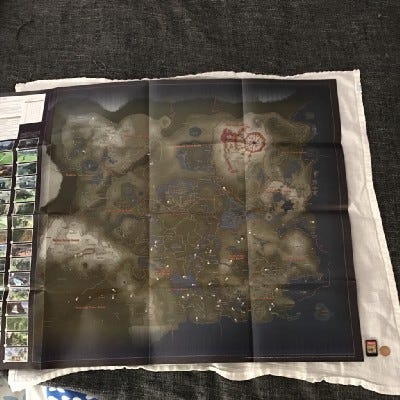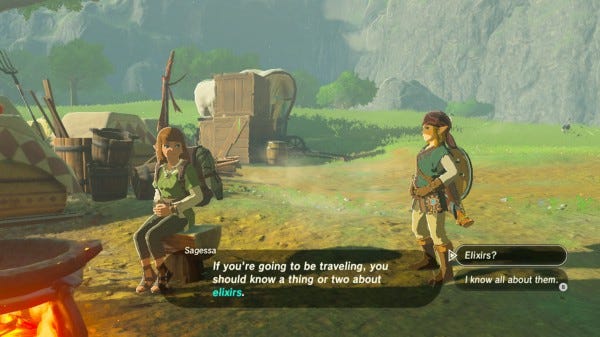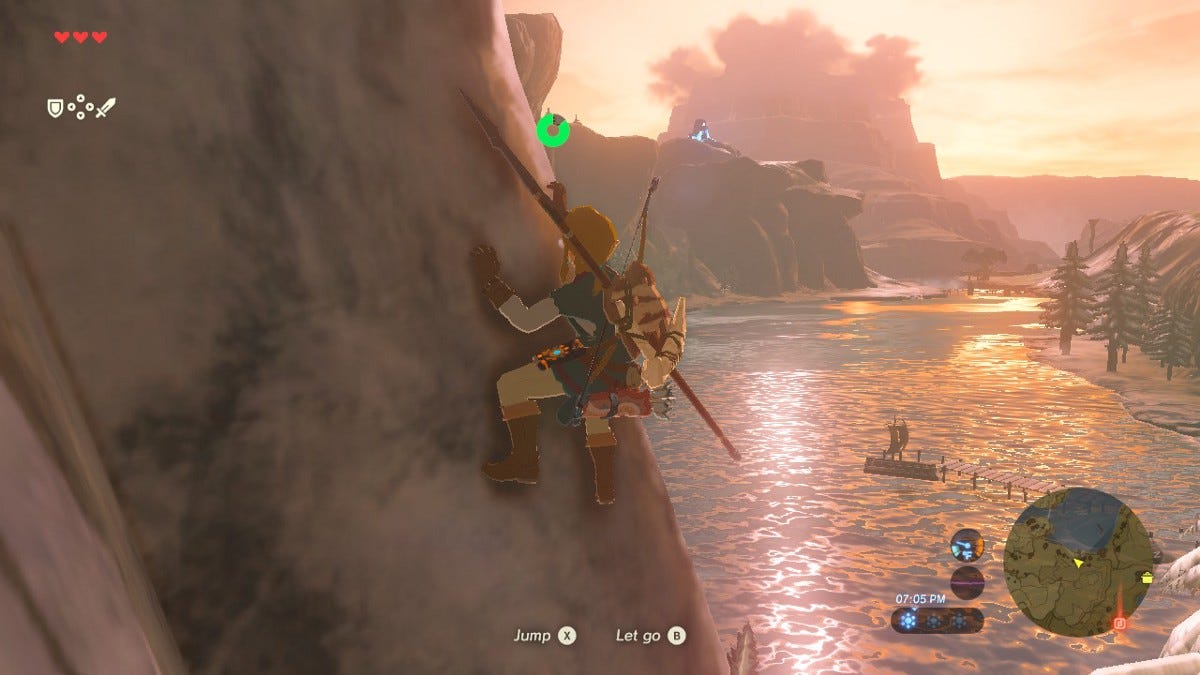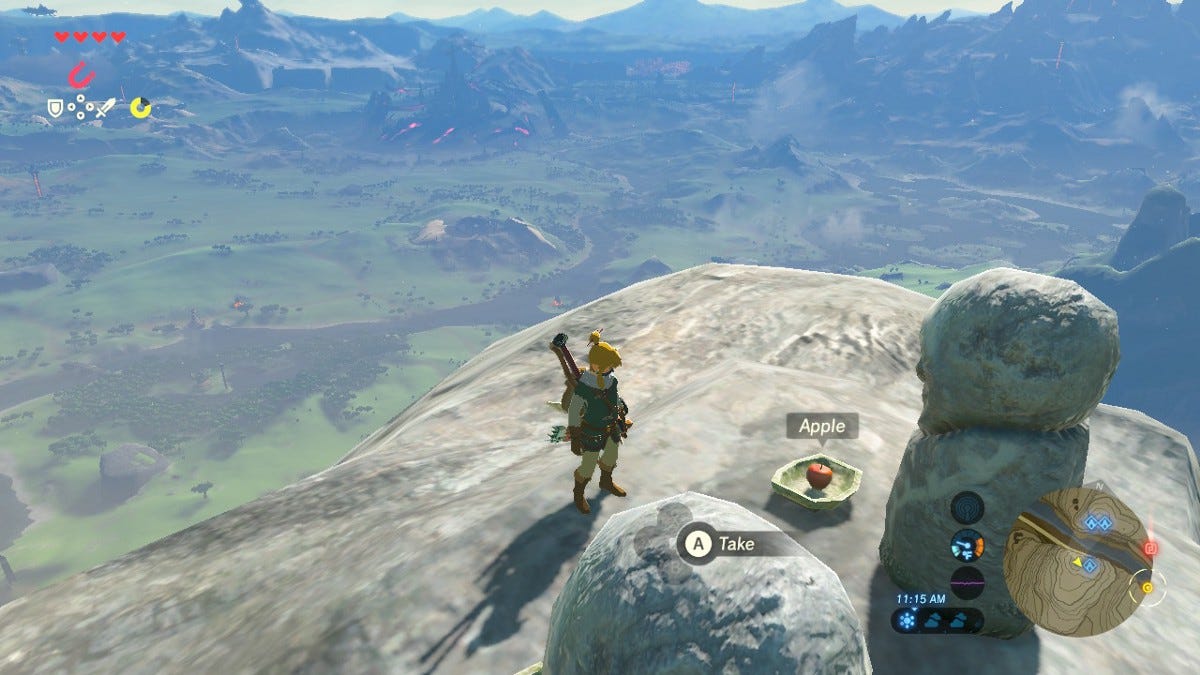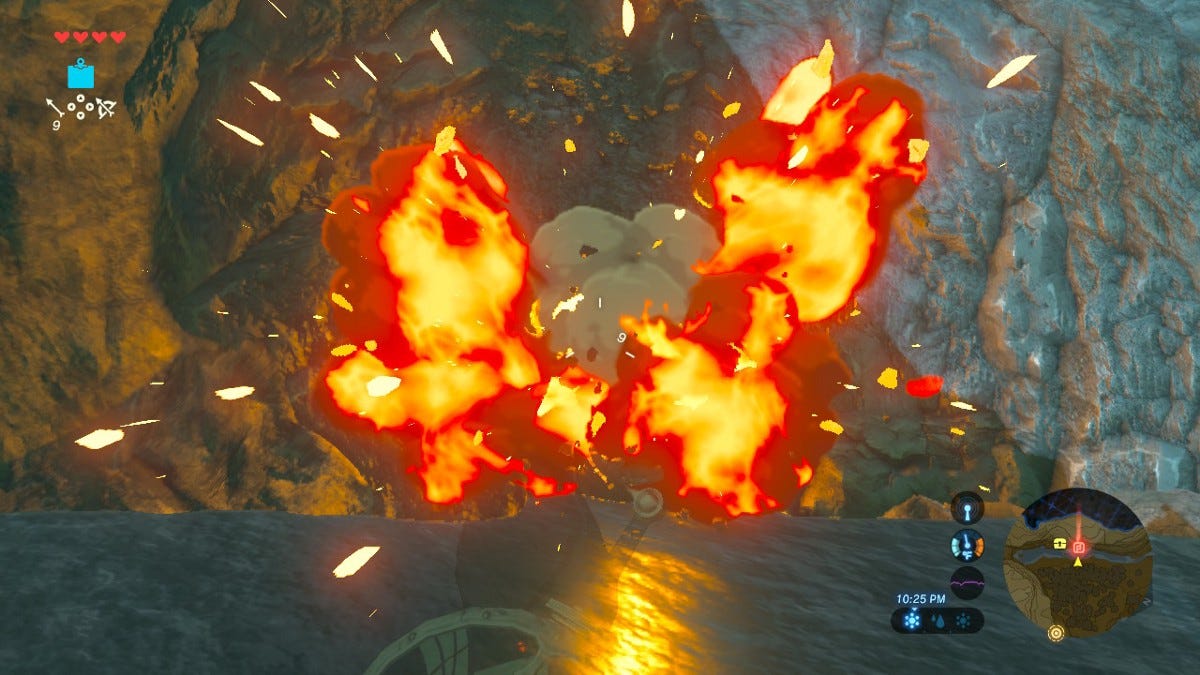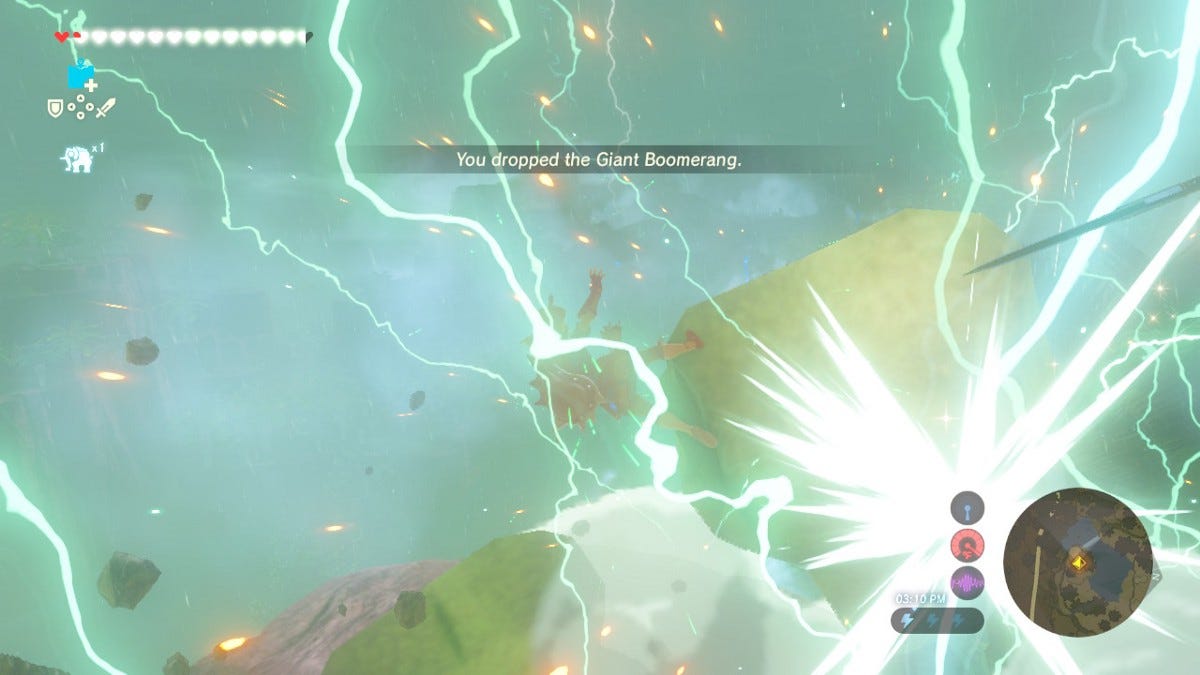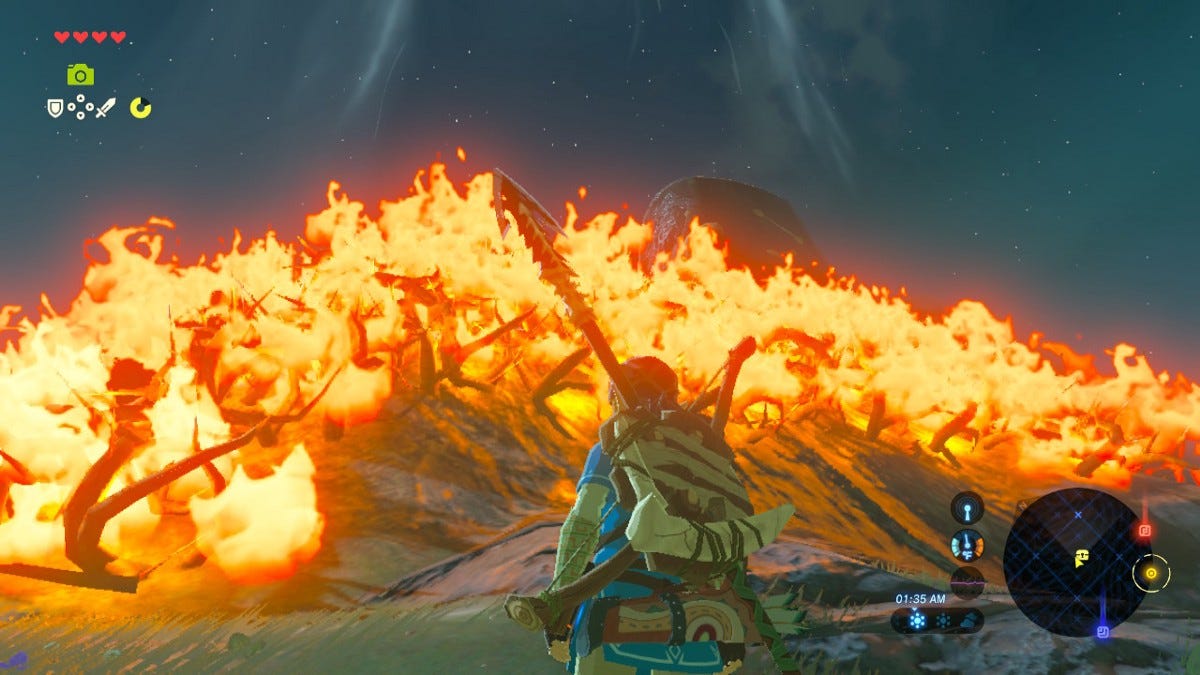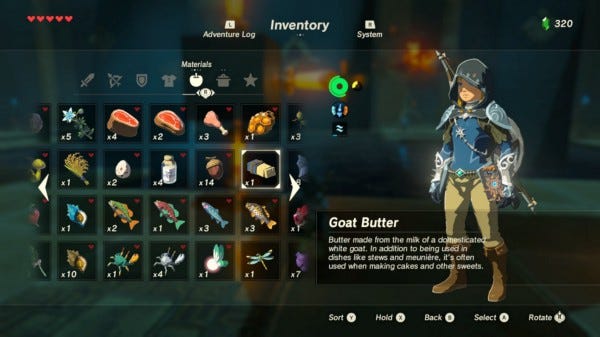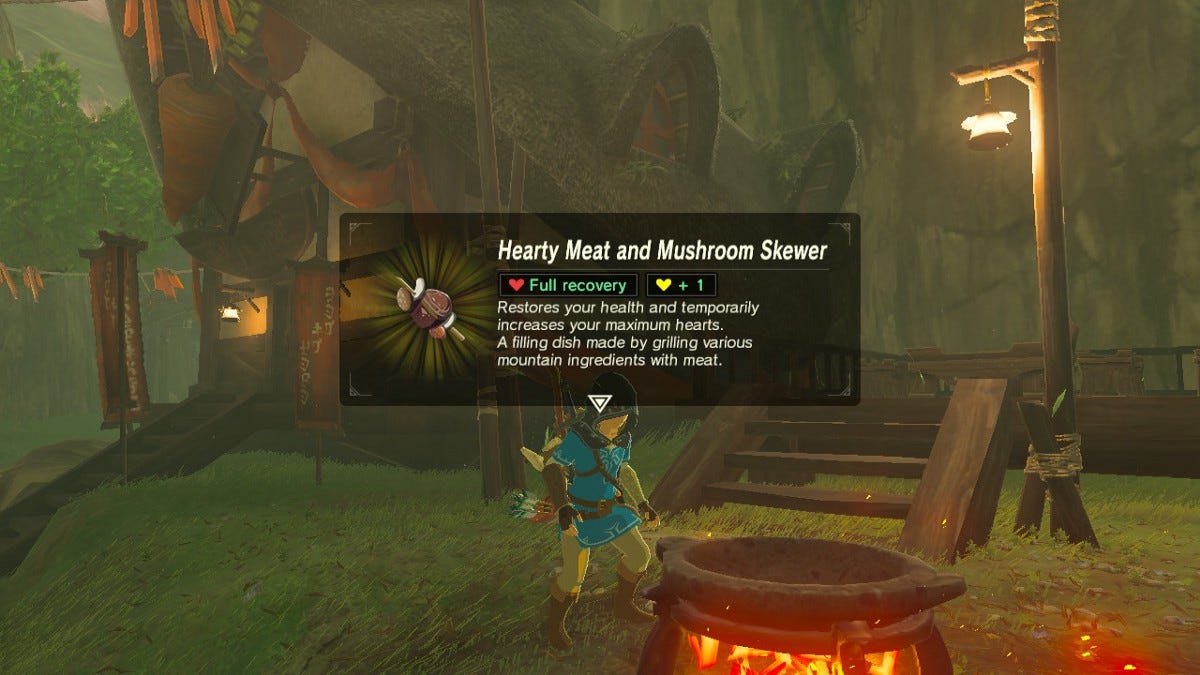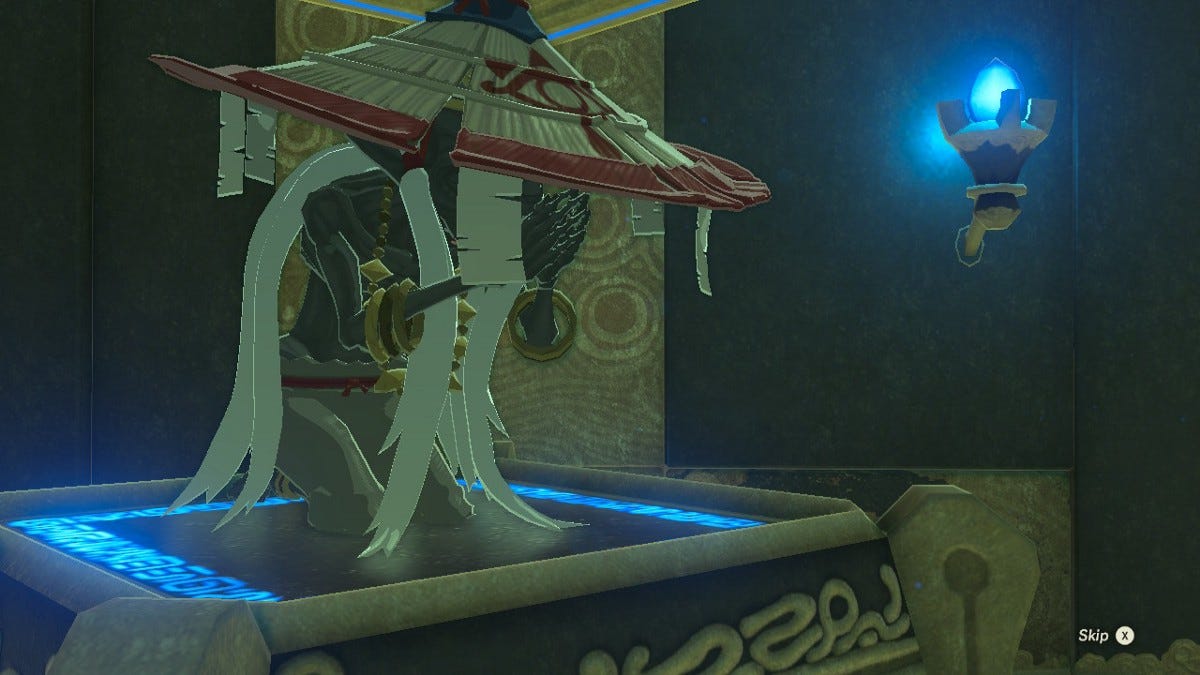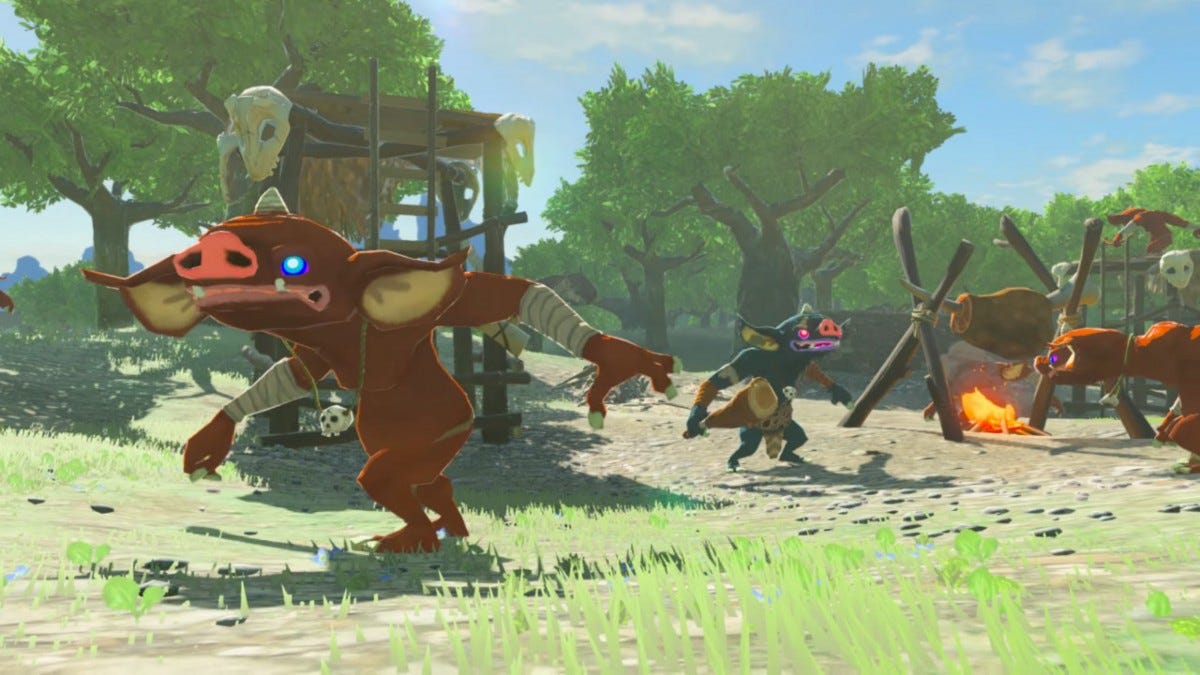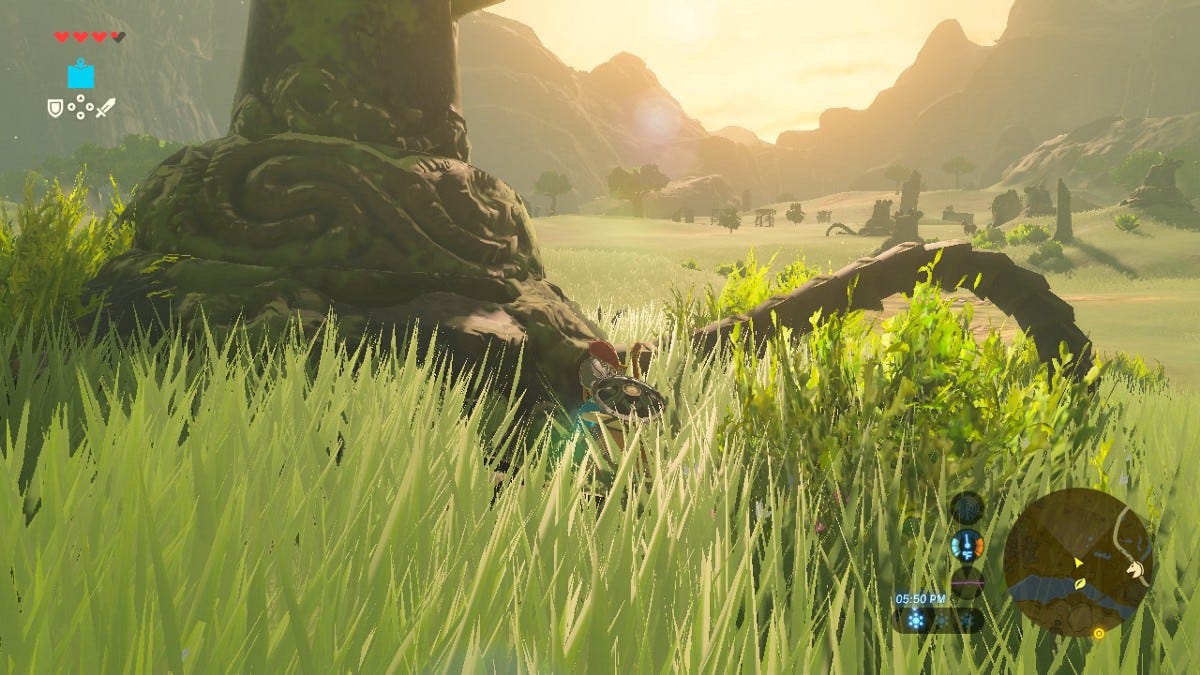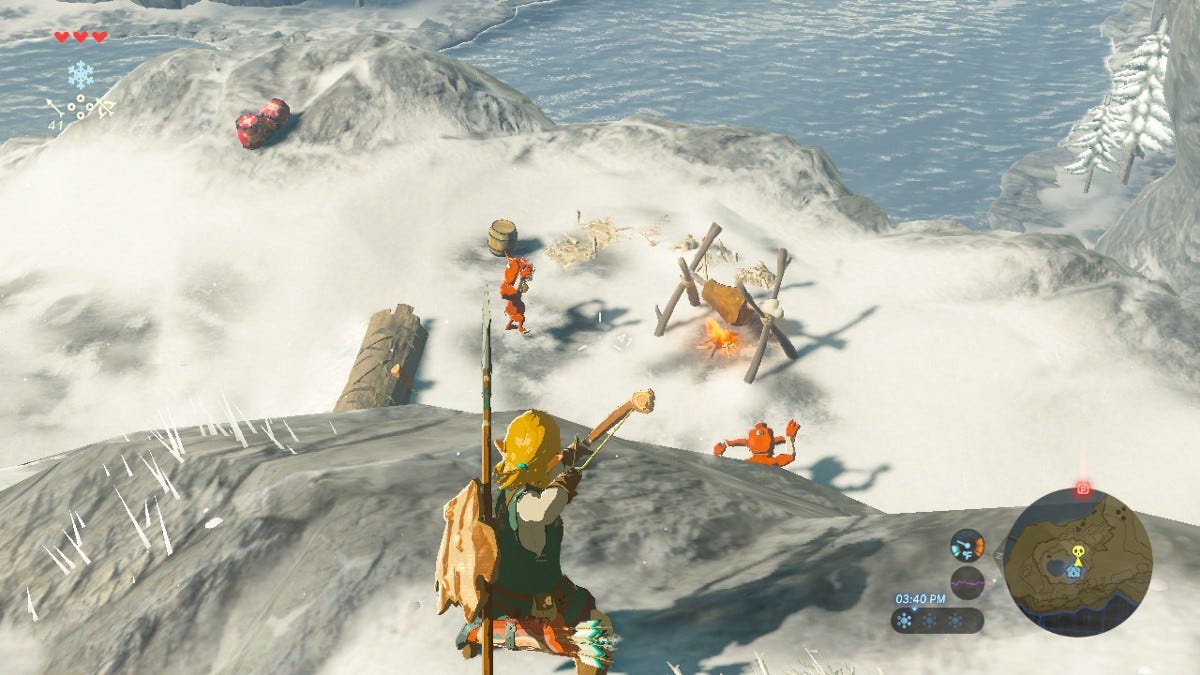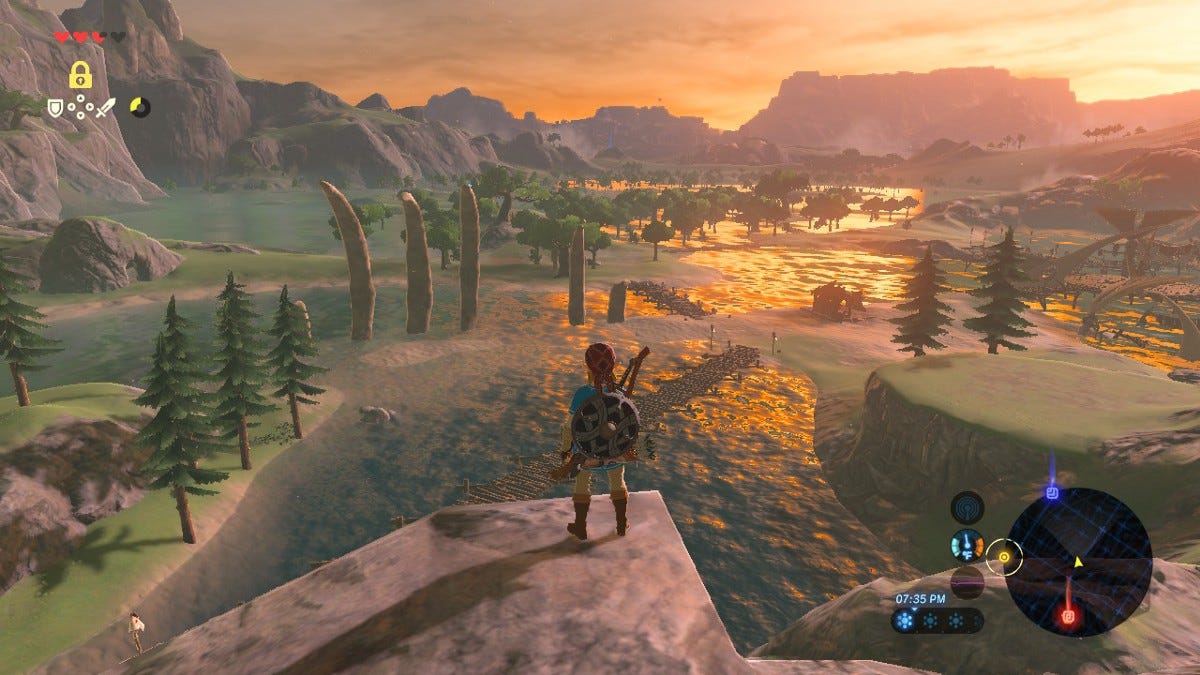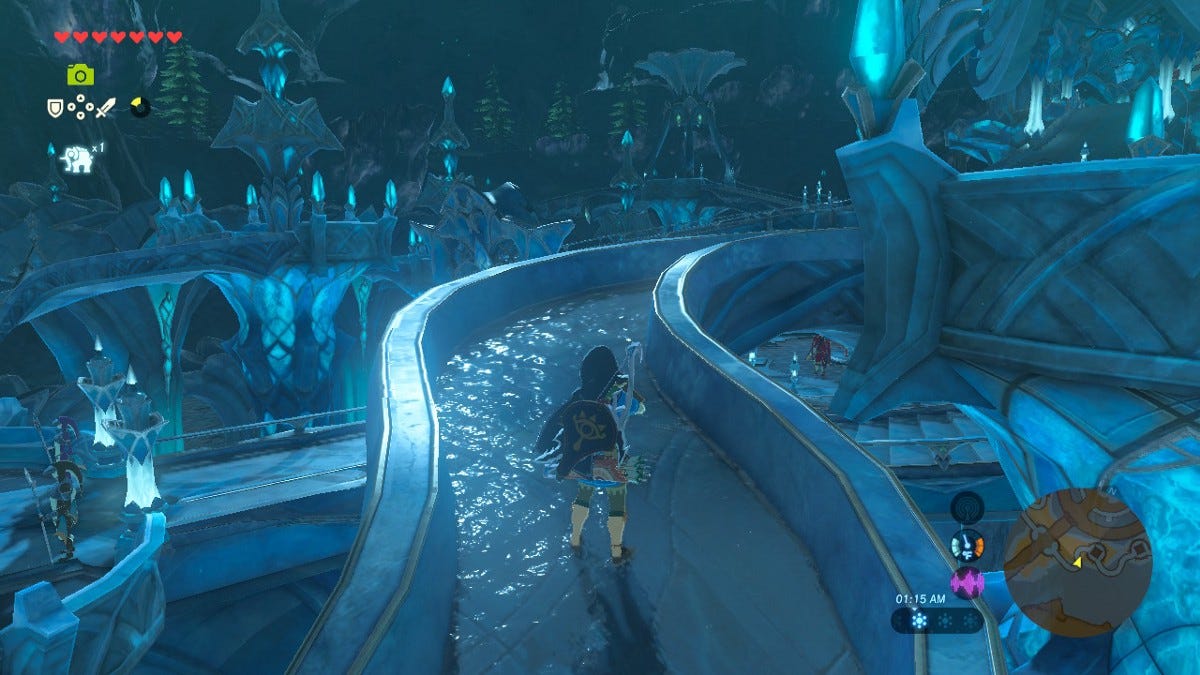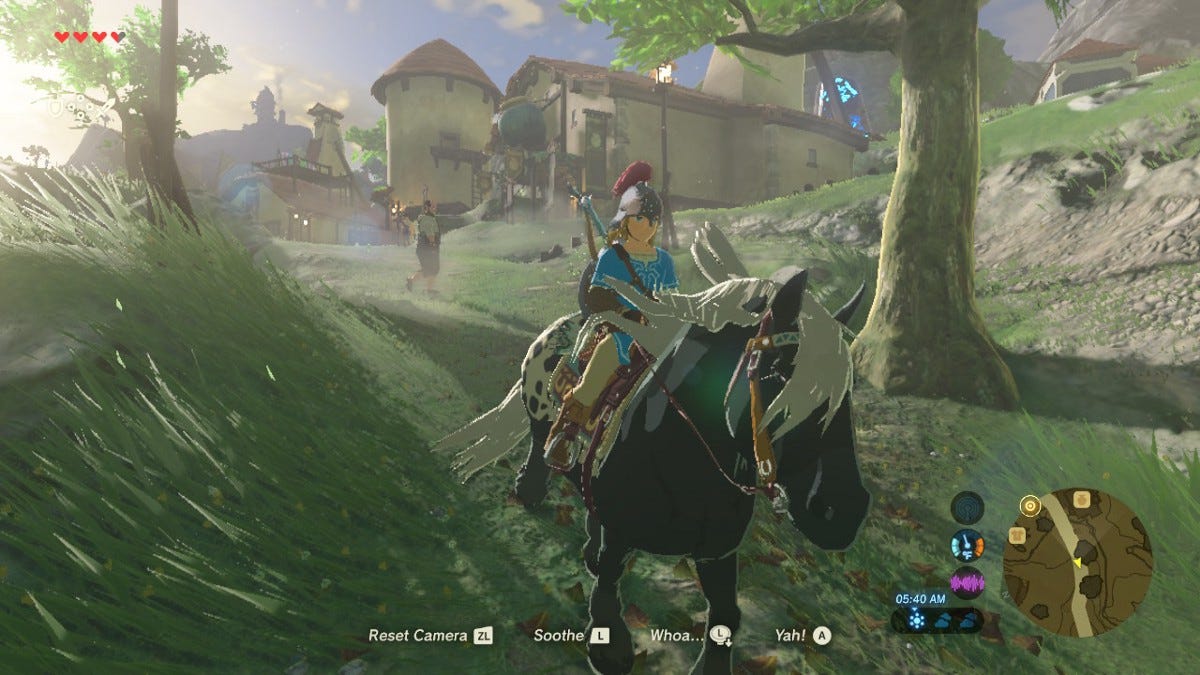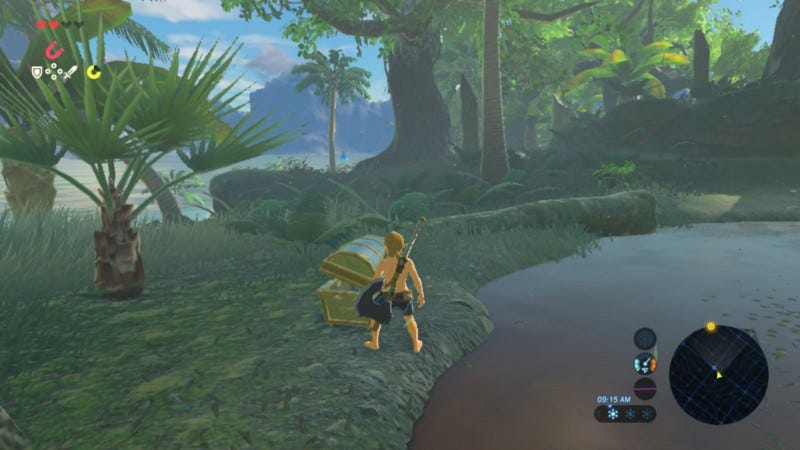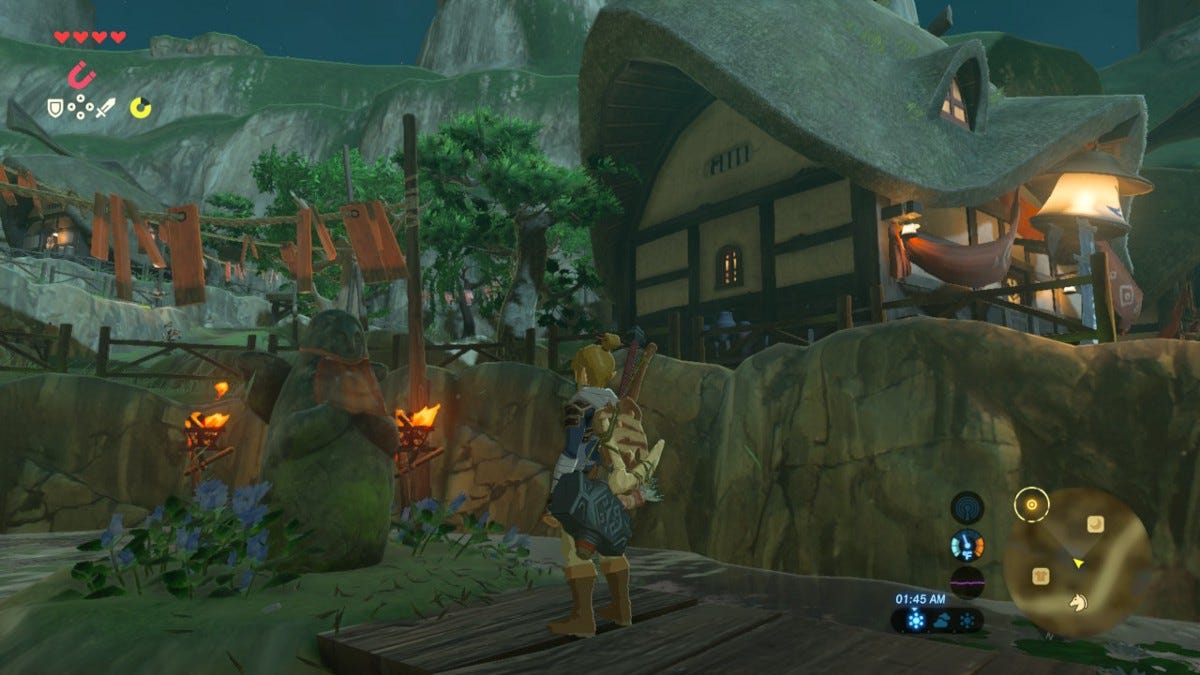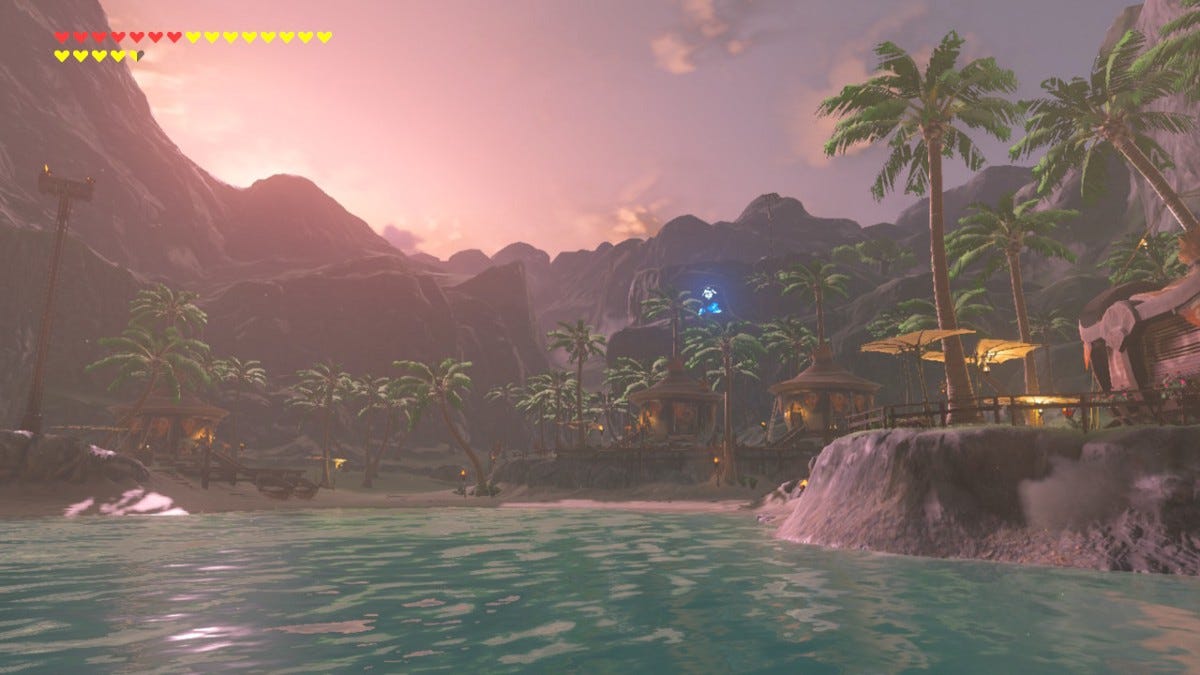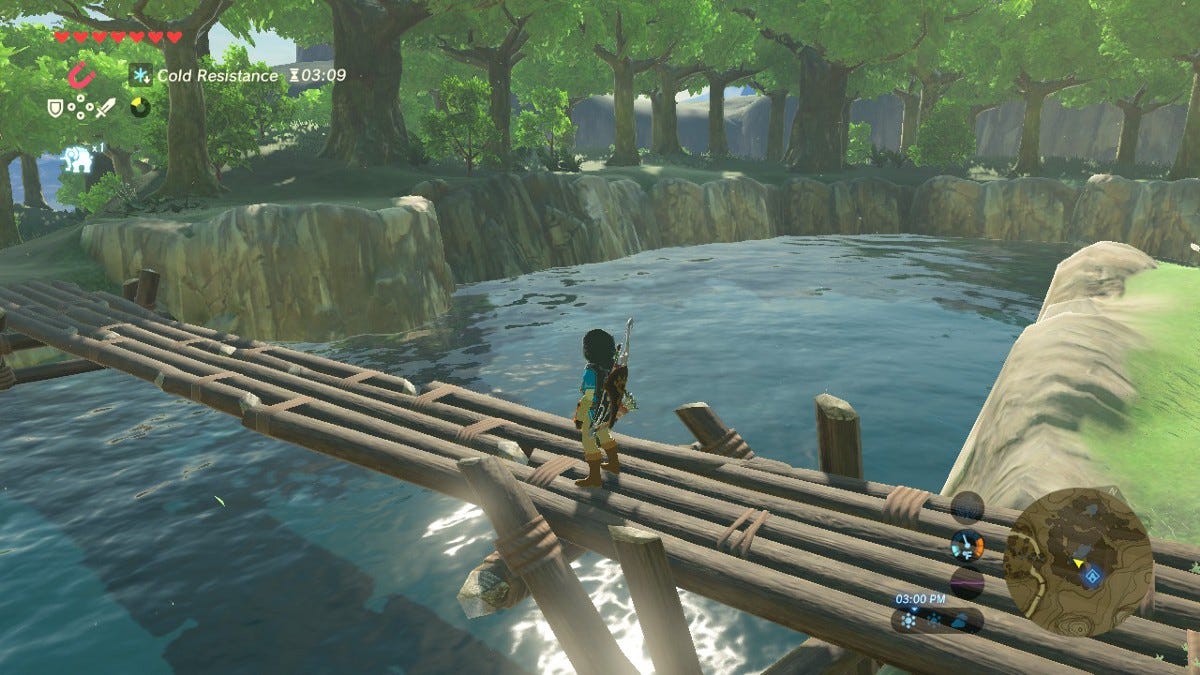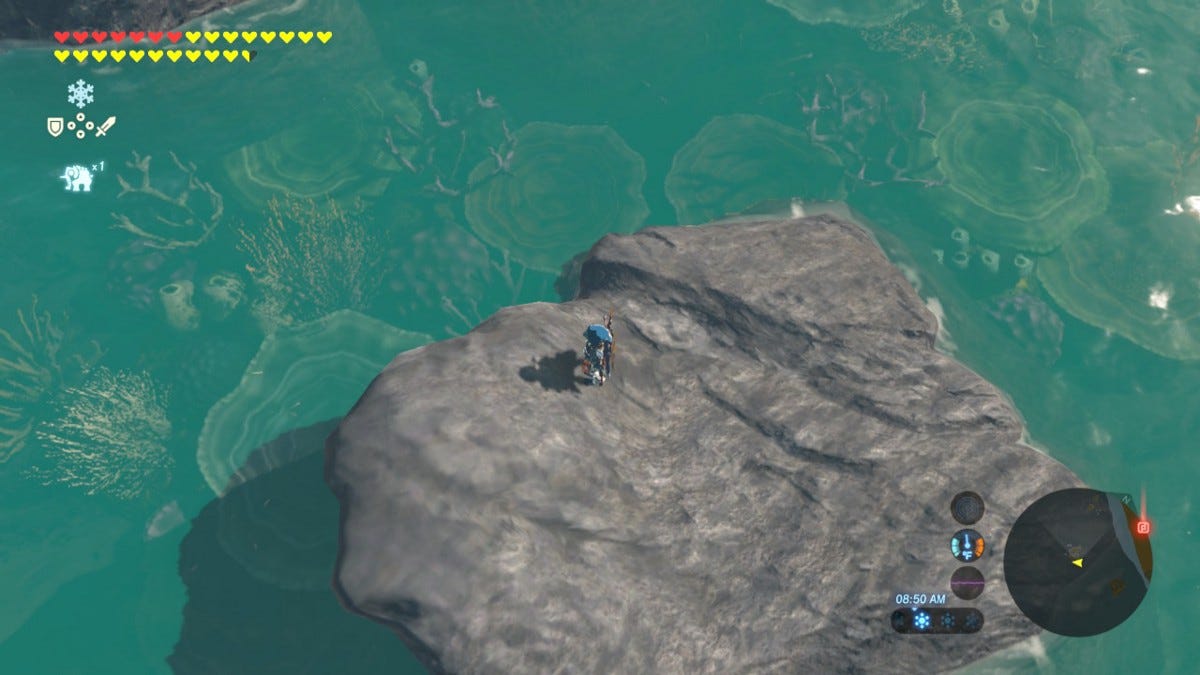Meditations on the Zen of Zelda, Link, and Hyrule
By now, you’ve probably read at least some of the many reviews fawning over The Legend of Zelda: Breath of the Wild. You know, the ones awarding the game perfect scores (10/10, 5 Stars, and so forth) and calling it a masterpiece while praising the game’s jaw-dropping scope, its beautiful and open world, its compelling story, its well-designed puzzles, its challenging and highly strategic combat, its attention to even the smallest details, and the sheer sense of awe and wonder that overtakes you while exploring the Kingdom of Hyrule.
But while all that is true, I won’t rehash any of that here—as I have a feeling you’ve read all those reviews and arrived at the same conclusions by playing the game anyway. If you’re anything like I am, you’ve spent the past few weeks exploring Hyrule, finding Koroks, and slaying Bokoblins in an almost obsessive (and certainly excessive) manner. And now, you want to go deeper.
Well, you’re in luck. In this piece, I will get at something none of the reviews have touched on so far, what I feel is Breath of the Wild’s most subtle and profound characteristic: the game serves as one big life lesson.
Yes, Breath of the Wild’s greatest innovation may lie in the many ways it forces you to think and play differently — in a manner that sticks with you, even spilling out into real life (which is something I hadn’t experienced from a game since the MOTHER series).
I’ve had many a chance to think about this while playing Breath of the Wild — these thoughts usually come to me during my several game-induced meditative states. And now, I will impart these thoughts to you.
SPOILER ALERT: I will not spoil the story in this post. But I will post original screenshots and describe locations and mechanics I’ve experienced during my ~30 hours playing so far. These may be spoilers for some people, you’ve been warned!
On Breath of the Wild’s Illusion of Choice
For my first meditation, let me introduce the paradox at the heart of Breath of the Wild: its freedom and openness are actually an illusion.
On first glance, this seems preposterous. After all, Breath of the Wild’s Hyrule is the most open world of the Zelda series, and possibly of any video game. You are given unfettered freedom to go where you want, when you want, and do what you want — you can even go straight to fight Ganon from the get-go.
But herein lies the rub: do you really want to fight Ganon right after you’ve started the game? Sure, it makes for a neat — and even fun — challenge. But you’d be missing out on all the story, exploration, and puzzles that come before it. Besides, Ganon would almost certainly make mincemeat out of you at such an early stage.
So the game, while on the surface giving you that option, very subtly forces your hand. It nudges you to complete the rest of the game first — very slyly and even unnoticeably, but it nudges you nonetheless.
And that’s just one of the many ways in which Breath of the Wild either encourages or straight up compels you to adapt your thinking and playing style to suit the game. Sometimes, these adjustments even have real-life implications! For example…
Breath of the Wild Forces You to Take Your Time
“There’s nothing wrong with things taking time.”
~James Dyson; inventor, entrepreneur
Breath of the Wild’s aforementioned sleight of hand with its final battle is just one example of the many times it’s made me take things as slowly as possible. In fact, the whole world is seemingly designed to make you stop and smell the (digital) roses.
The main quest is always on your radar (quite literally — its markers will stay on the in-game map unless you select another quest), but it’s almost impossible to solely focus on completing it. From any given Point A to Point B, there are dozens of side quests, shrines, baddies, puzzles, and landmarks to steer you off track. Completing the main quest — to say nothing of the side quests and shrines — will take much longer than I could have ever anticipated (before the game came out, I figured it’d take me 100 hours to beat it all. Now I think it’ll be closer to 200).
But this is a good thing! In this age of frenetic, fast-paced games (themselves a reflection of our frenetic, fast-paced lives), it’s refreshing to think to yourself “I’m going to take my sweet time with this.” You end up savoring every second of the game, which is a useful reminder to savor every second of your life.
On a similar note, Breath of the Wild will also make you a more patient person. Given all I’ve just pointed out, how could it not?
Breath of the Wild Invites Your Curiosity
“Curiosity is, in great and generous minds, the first passion and the last.”
~William Samuel Johnson, founding father
Another benefit of going off the beaten path is that you’re always rewarded for doing so. Side quests, puzzles, shrines, and combat bestow you with equipment, materials, or precious, precious rupees upon completion. Sometimes they also open up new side quests, which in turn lead to more goodies.
Oh, and this all takes place in a world that is positively HUGE. In fact, “huge” is a massive understatement (almost as big as the world itself). Words don’t even do it justice, so let me just demonstrate it to you with a picture of the map that came with the strategy guide:
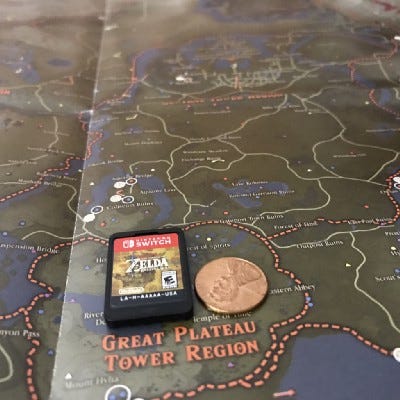
There you have it. Breath of the Wild’s Hyrule is enormous, colossal, gigantic, enormous, vast, and immense… and I’ve just run out of words to describe how big this world is. And it’s not just big — it’s densely packed with goodies to discover. You could spend hours in the Great Plateau region alone, trying to discover everything there.
Doesn’t this just make you want to go out there and find everything? If not, the positively pavlovian way the game conditions you to seek out treasures (that little chime that plays when I open a treasure chest is seared in my auditory cortex by now) will change that real quick.

The game doesn’t just reward your curiosity of its environs, however. It also rewards your curiosity of people. Villages, roads, and settlements are teeming with people, and talking to each person is a delight. Even the most trivial non-player characters (NPCs) are hashed out, their own distinct personalities bubbling to the surface. Sometimes, they’ll give you side quests, drop important hints, or give you life-saving information. Often, they’ll just deliver a humorous quip or regale you with their woes. Always, it’s a rich and enjoyable experience — and talking to people after long stretches of wandering through isolated wilderness is always its own reward.
This all serves to positively reinforce curiosity, exploration, and intrigue. By rewarding your curiosity, the game encourages you to check out anything that intrigues you — whether it’s an imposing cliff in front of you, smoke rising up from a distant forest, or that funny-looking villager singing a goofy song to himself.
The game is right to nurture your curious side — intellectual curiosity is one of the most important traits a person can have. It’s what drives us to learn more about ourselves and the world around us, and it has profound implications for society at large — because ignorance and curiosity are mutually exclusive. Curiosity leads to enlightenment—first on an intellectual, then on a collective, level.
Whether or not curiosity in the game leads to curiosity in real life is an open question — but if it does, it could very well lead to a betterment of society (or at least of the player).
Breath of the Wild Fills You with Wonder
“Look at everything always as though you were seeing it either for the first or last time: Thus is your time on earth filled with glory.”
~Betty Smith, “A Tree Grows in Brooklyn”
Let’s go back to exploring the environment. Even if there’s no treasure on top of that mountain you climbed, the game rewards your efforts with something arguably better: stunning views and vistas of the world you live in.
I can’t adequately describe the awe I’ve felt after scaling a big mountain and seeing the world open up in front of me. Or the giddiness I feel when I then pull out my scope and look out into the distance: in one direction, I see a smoldering volcano. In another, moonlight reflected on the ocean’s surface. In yet another, a shooting star that crashes in a distant plain (which I could go and retrieve). Closer to my vantage point, I spot an eagle flying and screeching through the valley, and a fox poking its head out from the grass.
Remember seeing the ocean for the first time? If you can’t remember that far back, how about the first time you saw a major landmark like the Grand Canyon or the Golden Gate Bridge? It’s the same feeling: awe and wonder. It makes you forget about all your problems, and connects you to this greater world we live in. It quite literally gives you perspective on life.
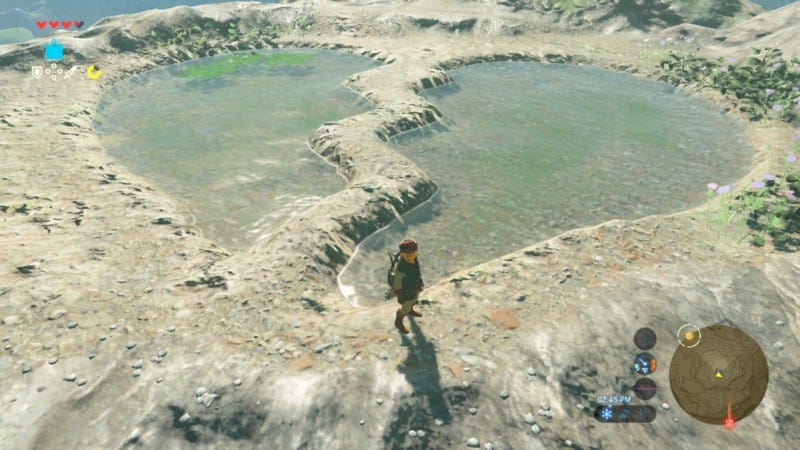
Of course, I’m not saying that seeing a virtual ocean is as awe-inspiring as seeing the real ocean… but in Breath of the Wild, it comes pretty damn close.
Breath of the Wild Encourages You to Experiment
“Necessity is the mother of invention.”
~Plato, ancient philosopher
Breath of the Wild has proven, once and for all, that the major game studios have got it all wrong: to create a truly immersive experience, you don’t need increasingly photorealistic graphics (that ultimately end up looking the same from one game to the next). You need to create a video game world that works like the real world!
This rendition of Hyrule feels like it could be a real place, even when you account for its dragons and advanced ancient technology. Wood and plants catch on fire. Metal attracts lightning. Rain makes you slip off of rocks, but also masks your footsteps to make it easier to sneak around. Everything makes sense in this world.
Which, of course, means this world begs you to experiment with it. Need to cross a gorge? Chop down a nearby tree and see if the trunk’s long enough to walk across. Want to cook some fish, but don’t have a fishing rod? Toss a bomb in a pond. Is a maze of thorny hedges blocking your path to a shrine? Set it ablaze with a fire arrow. In this world, if it’s seems crazy enough to work, it usually will.
This is another area of subtle brilliance on Nintendo’s part. Breath of the Wild is packed with puzzles, and solving them usually comes down to manipulating the environment in a certain way. And often, there is more than one way to solve a puzzle. Some solutions feel cheap, even like “cheating,” but the game will accept any solution you’re clever enough to arrive at. It’s incredible.
Similarly, one of Breath of the Wild’s underplayed achievements was creating a crafting system that’s actually fun and easy to use. In Hyrule, you are a scientist, and cooking pots are your lab. Your experiments with the cooking pot will yield meals and elixirs if successful… and a pixelated blob otherwise (fortunately, materials are plentiful, so your failed experiments won’t sting so much).
During your travels, you will pick up loads of ingredients: meat, fruit, herbs, monster parts, and minerals. When you get to a cooking pot, you’ll be able to experiment in combining ingredients to make tastier (and more restorative) meals or stronger potions. Ingredient combinations make intuitive sense: food doesn’t mix with monster parts or bugs, greens balance out meats, salt and honey enhance a meal, and peppers increase your cold resistance (vital for not freezing to death in snowy areas). The amount of possible results seems infinite — and most of them look delicious.
Even starting the cooking pot requires experimentation. Before you can cook, you need to light a fire under it. So how do you do it? Using a torch is the easiest and most straightforward solution — though I’ve also found striking a piece of flint with a sword does the job just as well.
Breath of the Wild Makes You Practice Non-Attachment
“Dare to live by letting go.”
~Tom Althouse, writer
I’m almost ashamed to admit that I’m a video game hoarder. Whenever I play a game, I hoard everything I find: money, items, weapons, you name it. I do this because I’m scared of wasting, losing, or breaking my best items before I truly need them — say, for a big boss battle. But ultimately, this results in a bunch of really cool items I’ll end up never using (maybe once or twice during the final boss, if I’m lucky), as well as one set of items I’ll use for most (if not all) of the game.
But not in Breath of the Wild. The game is forcing me to change my entire approach to items, namely by making sure I don’t get too attached to or hoard any of them.
Take weapons, for example. You don’t start the game with a weapon — the first weapon-like item you can pick up is a stick. Which breaks easily. And baddies are everywhere. But after defeating a baddie, I pick up its weapon, which lasts a little longer. Then I defeat more baddies and steal their treasure — a spear! Jackpot! I decide to save it for when I’m really in a jam.
…Which happens about five seconds later. I’m ambushed by a pack of Bokoblins, who quickly surround me. I frantically equip the ultra-powerful spear I found, which I use to barely defeat the horde… while breaking it in the process. But then I look through the weapons they dropped…
Later, rinse, and repeat.
This mechanic of weapon durability, unprecedented for a Zelda game, means that I will never hold onto a single weapon forever. Not only do weapons break, but your weapon inventory space is limited — which means that in order to pick up a weapon, I often have to let go of another. This leads to some arduous and painful decisions — but regardless, something is going to get left behind, so I’d better get used to the idea.
The same principle applies elsewhere. At some point, you’re going to have to cook that special ingredient to get the boost you need to get through an area you’re stuck in. Your horse, which you’ve spent hours taming and bonding with, will probably get slain by a Moblin at some point. You may encounter some shiny new armor that’s just beyond your price range — can you part with some of those rare items you’ve found so you can afford it?
Between its several contemplative and meditative moments, and its constant reminder of the follies of attachment in an ever-changing world, Breath of the Wild is a great demonstration of Buddhist principles (which everyone could stand to practice in their own lives!).
Breath of the Wild Forces You to Strategize and Adapt
“Adapt or perish, now as ever, is nature’s inexorable imperative.”
~H.G. Wells, author
Inventory management is just one area in which you, as a player, must show flexibility and adaptability in order to succeed. You must be nimble and fluid at all times when exploring Hyrule’s cruel and unforgiving environments. The time of day, weather, and terrain will dictate how to best proceed.
If it’s raining, you can forget about climbing that mountain, lest you slip and fall to your death. And if you hear thunder, you’d better get indoors quickly (or at least remove your metal weapons and armor). Don’t enter a snowy area without bundling up first. And let’s say you need to get from one village to the next: do you take the scenic route through the mountains, or take the quicker way (and risk an enemy encounter) by taking a road instead?
“Know your enemy and know yourself, and you can fight a hundred battles without disaster.”
~Sun Tzu, “The Art of War”
Speaking of enemies — they’re tough. Really, really tough. Even basic enemies can kill you with one blow if you’re careless enough, and groups of enemies can quickly overwhelm you. Each enemy encounter is potentially deadly, which forces you to adopt the best strategy for each group of meanies.
And the beauty of battle strategies is like the beauty of puzzles: there’s no right answer, and more than one way to take out a Bokoblin encampment. For example, you’ll probably want to take out sentries from afar with your bow and arrow, and use a long-reaching weapon (like a spear) to keep their comrades from reaching you. If you’re looking down at them from a ledge, you could roll a boulder on them, throw a bomb, or aim an arrow at a nearby explosive barrel.
Or, if you know there’s no way you can take a particular group on head-to-head, you could always wait until nightfall when they’re all asleep to sneak past them (and maybe grab some of their loot in the process), or distract them by throwing a piece of raw meat to their side. Then come back later when you have a stronger weapon.
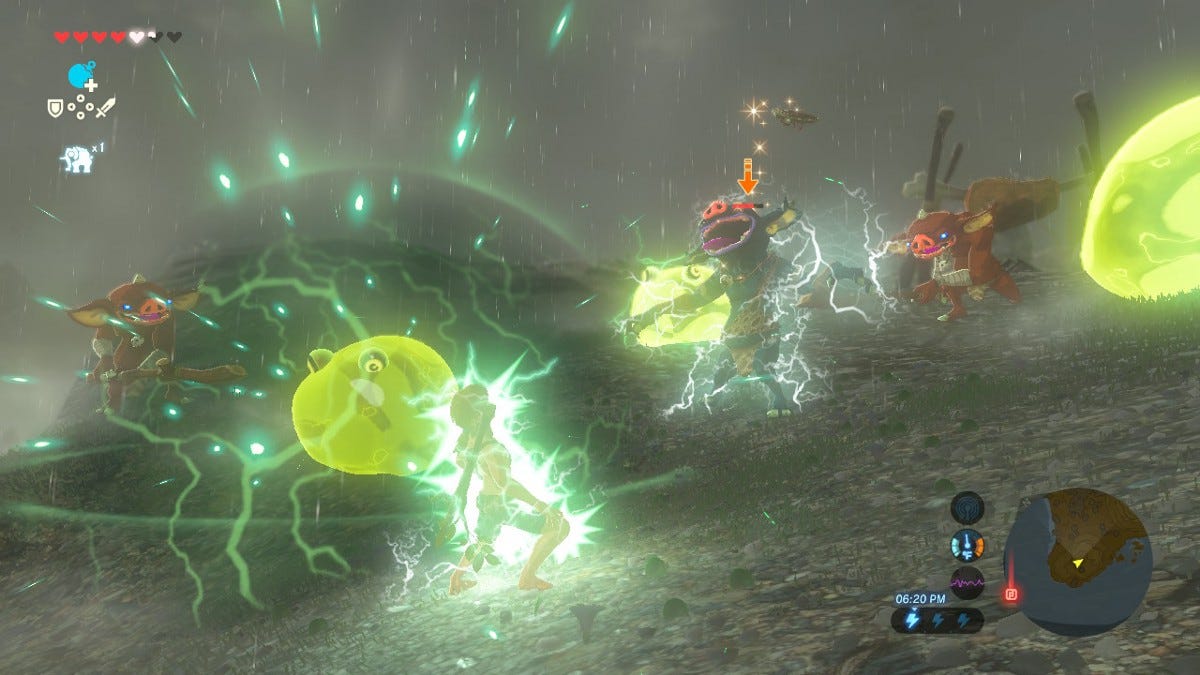
Breath of the Wild has loads of different types of weapons, shields, bows, and monsters. An ax is slower to swing than a sword, but also packs more of a punch. Just like bigger monsters lumber around slowly, but pack a painful wallop. Each variable will affect the battle and determine the best strategy to use. And I haven’t even mentioned the status enhancements and special techniques you can employ (for example, if your timing is right, you can parry an incoming attack and counter with a flurry of quick swipes).
All in all, you have to find the strategy that best suits your circumstances and your playing style. Which brings me to my final thought…
Breath of the Wild Lets You Find Your Own Way, and in Doing So, Find Yourself
“The best part of traveling is finding yourself.”
~Ken Poirot, author
Really, you can disregard everything I’ve just said. At the end of the day, these are just my own observations, based on what I’ve experienced in the game so far (which, admittedly, isn’t very much). During your own play-through, you will make observations of your own. And you may arrive at some of the same conclusions, but most likely, you’ll take something completely different from the whole experience.
And that, right there, is the ultimate beauty of Breath of the Wild.
While Breath of the Wild will impart many shared experiences to players, everyone will experience it in a different way. Even though Hyrule is not a randomly-generated world, and different players will play through the same story, find the same characters, and visit the same key locations, everyone will play the game in their own way.
Some will be completionists, and won’t stop until they explore every nook and cranny and find every hidden item. Others are speedrunners, and will plough through in an attempt to set speed records for finishing the game. Some will tackle quests in one order, others in another, and still others in yet another. Some will prefer traveling on top of mountains, others through valleys. There are thousands upon thousands of different orders in which to tackle shrines and side quests. People will discover different things at different times. The end result is a vastly different game experience for each player — and even for the same player, should they choose to replay it.
Following a very brief “tutorial” section, players are left to their own devices to make the game, and their experience, unique to them. This results in a near-infinite number of paths through the game. I love talking to my fellow players for this very reason: every time I talk to someone who‘s also playing the game, I’m amazed at the different encounters and discoveries they’ve made—even though they’ve been playing the same amount of time I have. Even websites that host game walkthroughs are still busy uncovering Hyrule’s many hidden secrets.
It harks back to my days as a kid, talking with my friends at recess about the games we were playing. It was almost like we were reporting back to each other with new cool things to check out, new tips to finally beat that boss. It’s an incredibly special feeling, like you belonged to a little club, and one I haven’t felt since the late 90s (around the time of MOTHER 2…. hmmm, am I noticing a theme here?).
As you find your own way in Breath of the Wild, you’ll create your own story. This is best illustrated with a story from my own gameplay (mild mini-puzzle spoilers ahead):
One time, on a cliff overlooking the ocean, I saw an island way off in the distance. Based on my experience thus far, I figured there was treasure on that island. So I hopped on a raft and slowly made my way there. But as soon as I set foot on the island, a mysterious voice spoke to me, saying that the entire island was a “trial.”
Next thing I knew, I was stranded on a tropical island with no weapons, items, or even clothes. To make things worse, the island was crawling with Bokoblins and even a stronger-than-usual Moblin.
“Crap,” I thought. “What the hell did I get myself into?” I’m cautious by nature — I tend to avoid battles as much as I can — and felt way in over my head. Still, I proceeded. I eventually figured out what to do — and found a few powerful weapons hidden on treasure chests throughout the island. See, in addition to being cautious, I also found out I was greedy — if I see a treasure chest in this game, I will drop everything and go find it.
And that proved to be my downfall. For one of the treasure chests wasn’t actually a treasure chest — it was an Octorok (basically, an octopus that spits rocks at you) disguised as a treasure chest. It leapt up and fell me with one swoop. I was dead.
I respawned back where I initially boarded the raft (thankfully, with all my gear returned to me), and marked the island on my map, to return once I upgraded my hearts and armor.
I returned much later, and what I experienced was so awesome and fun, I even wrote a whole new blog post about it! (You can check it out here)
What’s coolest about that whole journey to the desert island was that it was part of my own experience, and my own in-game journey. Other players may not even happen upon the desert island, or won’t give up until they complete it right then and there — and that’s their own journey. This game lets everyone find their own way, choose their own adventures, and even—provided they’re open and reflective enough—find parts of themselves along the way.
(Besides, when was the last time a story about a desert island sounded so compelling instead of cliched? That’s cool, in and of itself!)
Closing Thoughts
The above thoughts came from my observations of the game after playing for about 30 hours — and I’ve still only covered a small fraction of the map, and haven’t even come close to discovering everything in store for me. That Breath of the Wild can provoke such thoughts in me after such a relatively short time speaks to how remarkable this game is.
Fact is, no words, no screenshots, and no amount of reviews could ever do this game justice. Breath of the Wild is transcendental; one of those rare video games that not only surprises and delights you, but also enhances your life (instead of just mindlessly entertaining you while your time on Earth slowly slips away). It’s the perfect example of video games as art, with as much potential to move and transform audiences as the best works of art, film, music, and literature.
The last game I felt achieved anything similar was 1994’s sadly under-appreciated EarthBound (MOTHER 2 in Japan). That game, which I first played as a child and still replay every few years, has always stuck with me — it made me laugh, made me cry, made me tremble with fear, and stuck with me for the rest of my life. I can still recite its witticisms by heart, point out random references to it in the real world, and carry around its relentless optimism of the ultimate triumph of good over evil… even when faced with impossible odds (its sequel, MOTHER 3, always moves me to call my mother by the time I finish it).
With Breath of the Wild, I already feel the same gut inkling that I felt with the MOTHER series — that this is something uniquely powerful, that will transform lives and forever change what we expect from video games (which the industry desperately needs, from a creative standpoint). And it’s opening up a whole new generation to the potential of video games at their finest: to amaze, to excite, to galvanize, and to bring together people in this polarized world through a shared immersion in the saga of Zelda, Link, and Ganon.
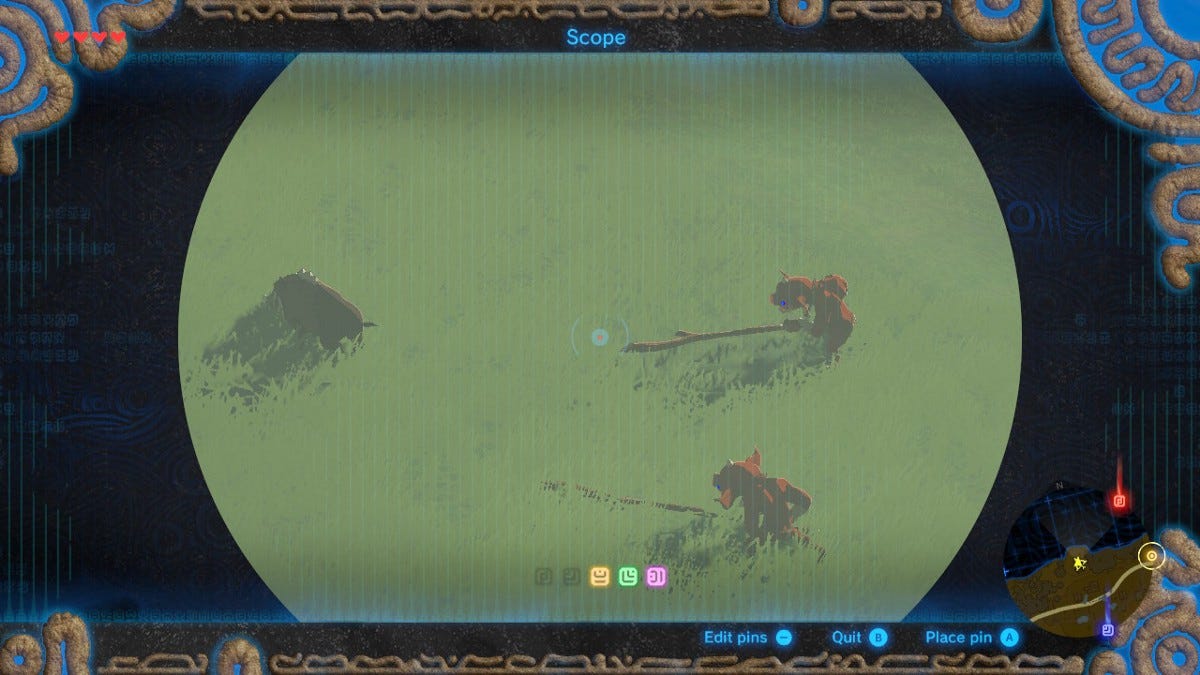
If you haven’t picked it up already, do yourself a favor and get a copy. Even if you’ve never played a Zelda game in your life — you don’t need to be a fan to get sucked in. I’m not exaggerating when I say it will transform your world.
Thank you for reading! If you enjoyed what you’ve just read, please recommend and share this article.
Jay Rooney is a lifelong Zelda fan. Hit him up on Twitter to discuss Breath of the Wild and other Zelda games. All screenshots are original and were captured with the author’s Nintendo Switch.


